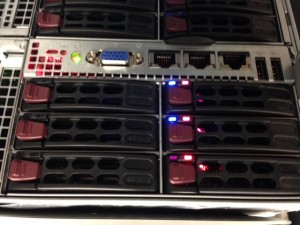VSAN build #2 Part 1 JBOD Setup and Blinkin Lights
 (Update, the SM2208 controller in this system is being removed from the HCL for pass through. Use RAID 0)
(Update, the SM2208 controller in this system is being removed from the HCL for pass through. Use RAID 0)
Its time to discuss the second VSAN build. This time we’ve got something more production ready, properly redundant on switching and ready to deliver better performance. The platform used is the SuperServer F627R2-F72PT+
The Spec’s for the 4 node’s
2 x 1TB Seagate Constellation SAS drives.
1 x 400GB Intel SSD S3700.
12 x 16GB DDR3 RAM (192GB).
2 x Intel Xeon E5-2660 v2 Processor Ten-Core 2.2GHz
The Back end Switches have been upgraded to the more respectable M7100 NetGear switches.
Now the LSI 2208 Controller for this is not a pass through SAS controller but an actual RAID controller. This does add some setup, but it does have a significant queue depth advantage over the 2008 in my current lab (25 vs 600). Queues are particularly important when dropping out of cache bursts of writes to my SAS drives. (Say from a VDI recompose). Also Deep queues help SSD’s internally optimize commands for write coalescence internally.
If you go into the GUI at first you’ll be greeted with only RAID 0 as an option for setting up the drives. After a quick email to Reza at SuperMicro he directed me to how to use the CLI to get this done.
CNTRL + Y will get you into the Megaraid CLI which is required to set JBOD mode so SMART info will be passed through to ESXi.
$ AdpGetProp enablejbod -aALL // This will tell you the current JBOD setting
$ AdpSetProp EnableJBOD 1 -aALL //This will set JBOD for the Array
$ PDList -aALL -page24 // This will list all your devices
$ PDMakeGood -PhysDrv[252:0,252:1,252:2] -Force -a0 //This would force drives 0-2 as good
$ PDMakeJBOD -PhysDrv[252:0,252:1,252:2] -a0 //This sets drives 0-2 into JBOD mode
Now if you havn’t upgraded the firware to at least MR5.5 (23.10.0.-0021) you’ll discover that you have red drive lights on your drives. You’ll want to grab your handy dos boot disk and get the firmware from SuperMicro’s FTP.
I’d like to thank Lucid Solution’s guide for ZFS as a great reference.
I’d like to give a shout out to the people who made this build possible.
Phil Lessley @AKSeqSolTech for introducing me to the joys of SuperMicro FatTwin’s some time ago.
Synchronet, for continuing to fund great lab hardware and finding customers wanting to deploy revolutionary storage products.


